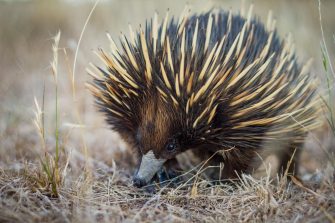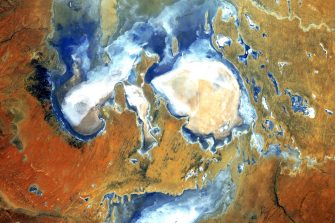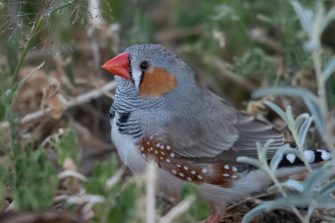Our research

Over 70% of Australia falls within the arid zone, which, due to its harshness, remains less than well understood. Fowlers Gap presents a unique opportunity to study the outback and understand its mysteries from the outside-in.
The University of New South Wales Sydney holds a perpetual lease to the station and plays host to many of its own researchers, as well as those from other institutions from Australia and around the world. The station is a base for understanding the physical and ecological processes that define the arid zone, and the behaviour and evolution of the organisms that call it home.
Quick links
Research opportunities at Fowlers Gap include a look at restoring arid zone ecosystems, geology, hydrology, and how these systems have been changed by pastoralism, with the site itself remaining an important station for its neighbouring and visiting communities. We are taking a Strategic Adaptive Management (SAM) approach to managing, understanding and appreciating the ecological and social dimensions of this landscape. The best way to demonstrate future opportunities, though, is by looking at our current ones.
Current research projects

Climate monitoring
Fowlers Gap has a series of 19 tipping-bucket rainfall gauges, two creek level gauges, a full climate station, 12 piezometers to record groundwater change, and 6 temperature arrays. The equipment was installed in 2013 as a part of the Federal Government-funded Groundwater Monitoring Component of the National Collaborative Research Infrastructure Strategy (NCRIS) that had been undertaken by UNSW.

Impact of grazing on vegetation & mammal communities in Australia’s arid rangelands
This study investigated the effects that grazing by sheep, goats and kangaroos have on vegetation structure and small mammal assemblages during a period of exceptionally dry climactic conditions in an arid landscape in far-western New South Wales. A comparison was made to examine the role of habitat structure, food availability, predation risk and mammal abundance inside and outside herbivore enclosures.

Behavioural ecology of the short-beaked echidna in the arid zone of Fowlers Gap
This research investigated the behavioural ecology of the Short-beaked Echidna (Tachyglossus aculeatus), particularly the relationship between resource selection/habitat preference and their movement patterns at Fowlers Gap Arid Zone Research Station.

Impact of large herbivores on the ecology of rangelands
This project is a long-term controlled-removal experiment that is examining the impact of large generalist herbivores on landscape function and biodiversity in the rangelands of western NSW. Subject to funding, this important experiment is planned to run for at least 15 years and will hopefully become an even longer-term monitoring site for assessing the impact of large herbivore grazing and climate change on an arid ecosystem in Australia.

Cognition in Australian skinks
This PhD study focused on examining cognition, specifically learning, behavioural flexibility and inhibitory control, in a number of Australian lizard species belonging to the Egernia group. Two of the species tested during the course of the study, the gidgee skink (Egernia stokesii) and the shingleback (Tiliqua rugosa), are very abundant at Fowlers Gap Arid Zone Research Station (and the surrounding area). In particular, the gidgee skink can only be found along the north-western border of NSW, making Fowlers Gap one of the few areas in NSW where this species can be collected.

AeroSpan operations at Fowlers Gap
The CSIRO’s AeroSpan Sun Photometer System was installed the Fowlers Gap site in April 2013. AeroSpan refers to the network of aerosol stations operated by CSIRO Oceans and Atmosphere since 1997. The system is part of the world-wide Aerosol Robotic Network (AERONET) managed by NASA Goddard Space Flight Center which performs systematic characterisation of global aerosol using automatic sun photometers. Fowlers Gap, one of 7 sites in Australia, contributes data from the arid region near the Kati Thanda or Lake Eyre Basin, and complements data collected at another CSIRO Aerospan installation at Birdsville, located approximately 1,300 km north of Fowlers Gap at the edge of the Strzelecki Desert.

The future keepers: assessing effects of thermal stress and resource limitation on ants
The key aim of this project is to predict how species that provide core ecosystem functions may change under thermal stress and differential resource limitation. Any changes to the biology and roles that these core species contribute (e.g., population dynamics, competition, mutualisms, metabolic rates, seed dispersal) could have substantial ramifications within an ecosystem. Ecologically important, ubiquitous and diverse organisms, such as ants, also represent ideal subjects for citizen science research. This project will reveal how species that provide core ecosystem functions will respond to a changing climate. In most parts of Australia, ants are the dominant ecosystem function providers. We will assess ant responses to a warmer climate at a range of sites across Australia.

Desert Fireball Network (DFN)
Meteorites are the oldest rocks in existence found on the Earth, the only surviving physical record of the formation and evolution of the solar system. They sample hundreds of different heavenly bodies. Potentially, meteorites offer a direct route to understanding our origins. But to decode that record we need to know where they come from. The Desert Fireball Network is designed to provide these data. In 2018, the DFN consist of 50 camera sites across Australia (150 globally). One of the DFN cameras is installed at the Fowlers Gap research station - one of only two cameras in NSW.

Soil moisture in patterned vegetation under extreme drought conditions
Fowlers Gap and the adjacent areas of western NSW and SA exhibit striking examples of dryland PVPs – periodic vegetation patterns. These are generally regarded as emergent structures that arise from the ill-understood interaction of plants, soils, and available moisture. Among the regional PVPs, the contour-aligned vegetation banding that occurs over significant areas on the low-gradient hillslopes along the NW side of Fowlers Creek has been investigated over a number of years, including the measurement of soil moisture along permanently-marked transects. Soil moisture conditions vary markedly with annual rainfall, including its variation with the state of ENSO (El Niño – Southern Oscillation).

Singing and breeding behaviour of wild zebra finches
Captive zebra finches are the key model system for studying the development and function of bird song. From studies with domesticated zebra finches we know that the male song functions in mate attraction since it influences female choice. In the wild, zebra finches pair at maturation at approximately 100 days of age, and maintain a close and faithful bond until either of the partners die. Throughout his life, the male keeps singing in several contexts, even in groups. Considering that zebra finches are not territorial and have few extra-pair matings, the behavioural and ecological function of singing in the model songbird remains largely unknown. In this project, we aim to study the singing behaviour of wild zebra finches in the context of their timing of breeding. We hypothesise that song functions in attaining breeding synchrony in the population since reliable environmental cues (such as day-length) are limited. This field season (September to December 2018) consisted of various activities to study the wild zebra finch population at Fowlers Gap.

Chestnut-crowned Babbler project
This is a long-term monitoring project of the Chestnut-crowned Babbler (Pomatostomus ruficeps) population is not in its 17th year (2020). It is one of the longest running projects of individually-marked individuals in Australia’s arid zone. The Upper Western District of NSW is currently experiencing a growing drought. Our main focus has therefore changed to endeavouring to understand the impact of this drought on the babbler population. Unsurprisingly, with more limited breeding and prolonged harsh conditions, the population is beginning to fall. With this fall comes new questions – which individuals survive?

The Australian Acoustic Observatory
The Australian Acoustic Observatory (A2O) is a continental-scale acoustic sensor network, recording for a five-year period across multiple Australian ecosystems. A2O will have approximately 400 continuously operating acoustic sensors collecting 2PB of sound data over the duration of the project. The project is funded by an Australian Research Council (ARC) Linkage Infrastructure, Equipment and Facilities (LIEF) grant of $1.8 million.
